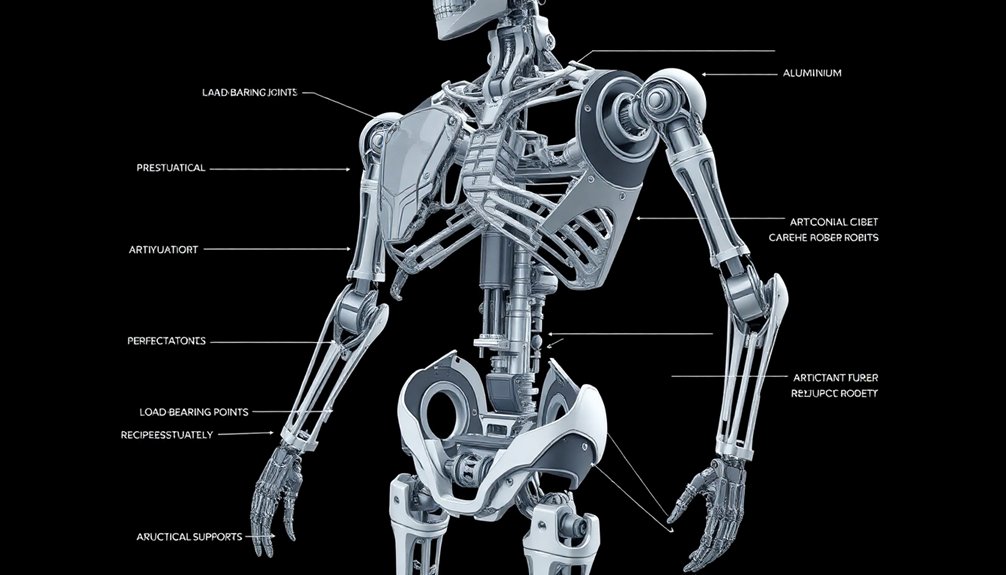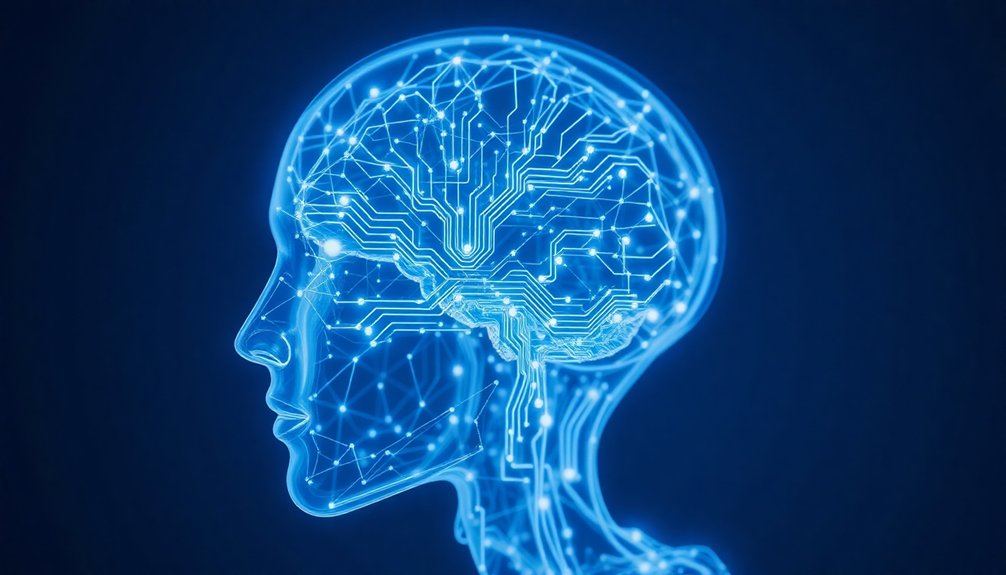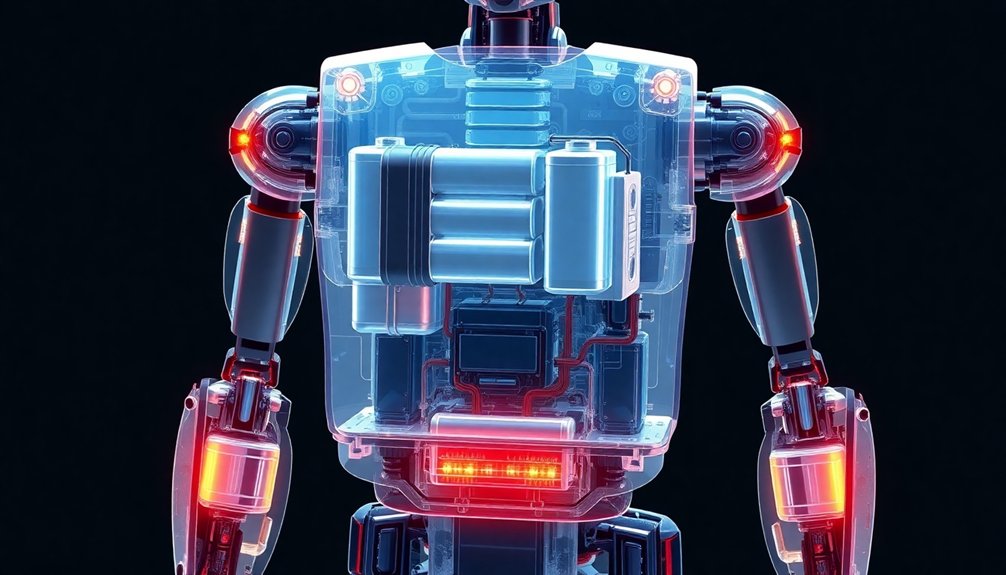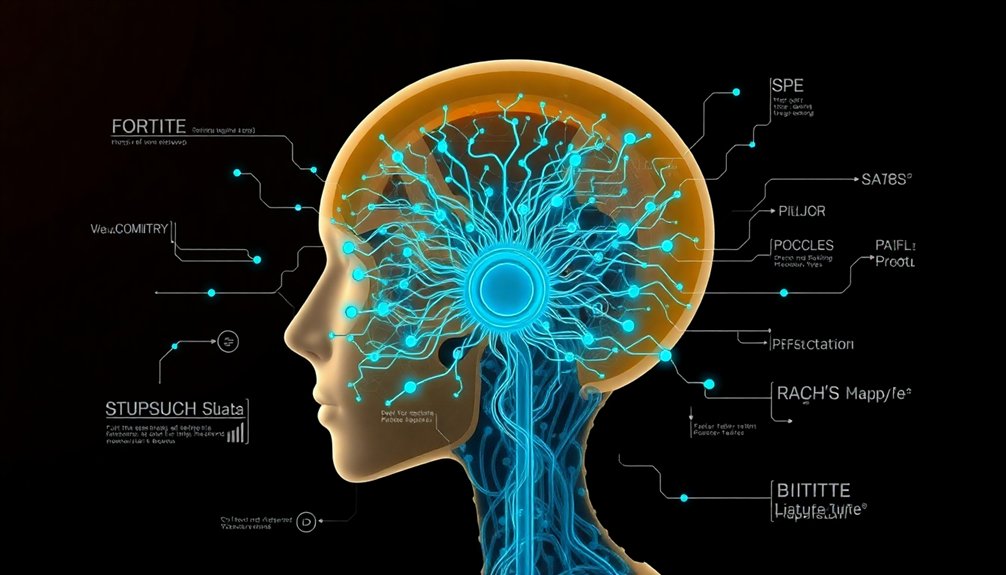Humanoid robots are basically humans without the drama, powered by lightweight metal skeletons, smart servo motors, and neural networks that turn electrical signals into mind-blowing moves. You’ve got sensors mapping environments in real-time, deep learning algorithms making split-second decisions, and hydraulic systems generating serious muscle power. Want to know how a machine might someday outperform your clumsy human reflexes? Stick around, and the future gets weird.
Building Blocks: The Mechanical Skeleton of Humanoid Robots

When you imagine a humanoid robot, you might picture a rigid, metallic structure—but the reality is far more nuanced. The mechanical skeleton isn’t just a bunch of parts; it’s an engineering marvel designed to mimic human movement.
Lightweight materials like aluminum and carbon fiber create a frame that’s strong yet agile. Servo motors and sophisticated joints transform robotic limbs from clunky mechanisms into fluid, almost-alive systems.
Transmission systems convert rotary motor movements into precise linear actions, allowing robots to bend, reach, and interact with environments almost like humans. Think of it as a high-tech skeleton that’s constantly evolving, pushing the boundaries of what’s possible.
Imagine a robot that moves not like a machine, but like a living, breathing entity—that’s the future of humanoid robotics. Advanced control systems enable these robots to perform complex tasks autonomously across various industries, blending sophisticated engineering with intelligent decision-making.
Power Generators: Motors and Actuator Systems That Drive Movement
Electric motors—ranging from brushless DC (BLDC) to precision servo types—are the unsung heroes that generate the precise torque and movement allowing humanoid robots to walk, grasp objects, and potentially outperform human physical capabilities. Robotic mechanical design mirrors human anatomical engineering, utilizing energy-efficient actuators that enable sophisticated and natural movements across various robotic platforms. Understanding how these power generators work isn’t just technical geekery; it’s a window into how machines are learning to mimic and potentially surpass human mobility and responsiveness.
Electric Motor Mechanics
Because electric motors are the beating heart of humanoid robots, understanding their mechanics is like peeking under the hood of our mechanical future.
These power generators transform electrical energy into precise movement, turning robots from static statues into dynamic beings.
- Servo motors deliver surgical-grade positioning for two legs, enabling robots to walk with human-like grace.
- Brushless DC motors maximize efficiency, reducing wear and extending mechanical lifespans.
- Torque output determines a robot’s ability to overcome physical resistance and perform complex tasks.
- Closed-loop control systems guarantee millisecond-level accuracy in motor performance.
Proprioceptive sensors enable robots to fine-tune motor movements with remarkable precision and adaptive intelligence.
Think of electric motors as the muscles of robotic anatomy—invisible powerhouses generating strength, flexibility, and potential.
They’re not just components; they’re the difference between a fancy paperweight and a machine that can potentially match human movement.
Want to understand the future? Start by understanding these tiny mechanical miracles.
Hydraulic Actuation Principles
Where electric motors flex like robotic biceps, hydraulic systems roar with raw, primal power. These bad boys leverage Pascal’s Law to transform tiny input forces into monstrous movements. As personal robots evolve, these advanced hydraulic systems become critical for creating more responsive and adaptive humanoid companions.
Imagine squeezing a tiny syringe and suddenly lifting a tank—that’s hydraulic magic for you. High power density means these actuators pack a serious punch, delivering explosive motion in dynamic environments with jaw-dropping precision. Operating at pressures between 1800 and 3000 psi, they can move loads that would make electric motors weep.
Sure, they demand meticulous maintenance—air bubbles, leaks, and worn seals can turn your robotic dreams into mechanical nightmares. But when calibrated perfectly, hydraulic systems turn humanoid robots from clunky machines into lightning-fast, superhuman performers.
Want real power? Hydraulics are your go-to technology.
Robotic Joint Movement
The neural network of robotic movement pulses through specialized motors and actuator systems that transform electrical whispers into thunderous mechanical dance. Your humanoid robot’s joints aren’t just metal connections—they’re sophisticated movement machines powered by cutting-edge technology. Humanoid robot manufacturers are continuously innovating motor technologies to enhance robotic joint precision and performance.
- BLDC motors generate high-efficiency rotational energy
- Servo motors deliver precision control at microscopic scales
- Planetary and harmonic gears convert motor output into powerful mechanical motion
- Sensor feedback loops enable real-time joint movement adjustments
These intricate systems work like your body’s muscles, translating electrical signals into smooth, calculated movements.
Imagine motors as the heart, actuator systems as the muscles, and gearboxes as the sophisticated nervous system translating complex commands into precise joint control.
Want fluid robot movement? It’s all about matching the right motors, understanding control accuracy, and letting sensor feedback be your robotic choreographer.
Sensory Intelligence: How Robots Perceive Their Environment
While humans rely on five basic senses, humanoid robots are cooking up something way more sophisticated. Their sensory intelligence isn’t just a fancy trick—it’s a complex web of perception that makes our biological senses look primitive.
Think cameras that see infrared, microphones that detect whispers, and touch sensors that map environmental nuances with millimeter precision. These sensors work like a superhuman nervous system, processing data through artificial intelligence algorithms that turn raw input into split-second decisions.
Imagine a robot maneuvering through a cluttered room, using multimodal perception to assess distance, predict movement, and interact with its surroundings. It’s not just watching—it’s understanding.
Gyroscopes, accelerometers, and proprioceptive sensors create a real-time 3D map of the world, letting robots move with an almost intuitive grace that’ll make your head spin.
Neural Networks: The Computational Brain Behind Robot Decisions

Ever wondered how robots actually think? Neural networks are the computational brains that transform humanoid robots from fancy metal shells into intelligent machines.
They’re like sophisticated decision-making algorithms that process sensory data in real-time:
- Deep learning techniques enable robots to recognize objects with superhuman precision
- Natural language processing lets them understand and respond to human communication
- Complex neural network layers simulate brain-like information processing
- Adaptive learning allows robots to improve performance through experience
These intricate computational models adjust connection weights, fundamentally “learning” by analyzing massive datasets.
By mimicking human cognitive processes, neural networks empower robots to navigate environments, interpret gestures, and make split-second decisions.
It’s not magic—it’s mathematics meeting machine intelligence, turning sci-fi fantasies into technological reality.
Who’d have thought lines of code could create something so eerily smart?
Motion Control: Precision Engineering of Robot Locomotion
When you’re engineering the muscles and joints of a humanoid robot, you’ll quickly realize it’s less about brute force and more about surgical precision.
Your choice of motors and gearing isn’t just technical—it’s the difference between a robot that stumbles like a drunk uncle at a wedding and one that moves with the grace of a ballet dancer.
Mastering robotic locomotion means understanding how tiny mechanical innovations can transform clunky machinery into something that can walk, balance, and interact with environments as naturally as a human.
Robotic Joint Motion Design
Because robotic locomotion isn’t just about fancy sci-fi walking, joint motion design represents the secret sauce that transforms rigid machines into fluid, almost-human movers. Robotic joints are the unsung heroes of humanoid robots, using cutting-edge servo motors and advanced robotics technology to orchestrate precise movements.
- Dynamic feedback systems allow robots to adjust motion in milliseconds
- Planetary and harmonic gears minimize mechanical wobble
- Motion control algorithms mimic human biomechanical patterns
- Specialized actuators translate digital commands into smooth physical actions
Your robot’s ability to walk, grasp, and navigate isn’t magic—it’s meticulous engineering. Imagine thousands of micro-calculations happening every second, translating computational instructions into graceful mechanical ballet.
These robotic joints aren’t just mechanical parts; they’re the nervous system turning silicon and metal into something that moves with startling, almost-living precision.
Precision Motor Selection
The heart of a humanoid robot’s movement beats through its motors—those miniature powerhouses that transform electrical signals into mechanical magic. Precision motor selection isn’t just technical wizardry; it’s the difference between a robot that stumbles and one that dances.
You’ll want high-torque motors that deliver serious punch, coupled with smart gearboxes that optimize every mechanical whisper. Control systems become the robot’s neural network, translating electrical impulses into fluid, human-like motion.
Think of these motors as the robot’s muscles—planetary gears act like sophisticated tendons, enabling incredible dexterity.
Want a robot that can grasp a delicate teacup or navigate rocky terrain? Your motor choices are the secret sauce. It’s engineering poetry: electrical input becomes graceful, calculated movement. Who said robots can’t have soul?
Advanced Locomotion Mechanics
From precise motor selection to the choreography of robotic movement, locomotion mechanics transform electrical whispers into a ballet of mechanical precision.
Advanced locomotion mechanics isn’t just about moving; it’s about moving with purpose.
Your humanoid robot’s movement relies on:
- High-torque motors that convert electrical signals into smooth, responsive actions
- Real-time balance adjustments that prevent embarrassing robot tumbles
- Sophisticated control systems tracking every microscopic movement
- Gear mechanisms reducing mechanical backlash for pinpoint accuracy
Precise control emerges from a complex dance of sensors, algorithms, and mechanical components.
These systems continuously recalculate the robot’s center of mass, ensuring stability across unpredictable terrains.
Imagine a machine that can walk, bend, and react with almost human-like fluidity—that’s the magic of modern robotic locomotion.
Who said robots can’t be graceful?
Joint Mechanics: Translating Human-Like Movement
When engineers crack the code of robotic movement, joint mechanics become the secret sauce transforming rigid machines into fluid, almost-human performers. Your favorite humanoid robots rely on advanced joint designs that mimic human balance with shocking precision.
Think of these joints as superhero connectors: they blend linear motion and rotational capabilities, giving machines 28 degrees of freedom that practically dance across surfaces.
Servo motors and harmonic gears do the real magic here, allowing robots to adjust movements in milliseconds. Real-time feedback systems constantly recalibrate, ensuring each motion looks natural and intentional.
Imagine a robot that can delicately grasp a teacup or sprint across uneven terrain—that’s the power of next-level joint mechanics. Pretty wild, right?
Energy Management: Power Sources and Efficiency Strategies

After orchestrating those mind-blowing joint mechanics that make robots move like liquid silk, engineers face their next grand challenge: keeping these mechanical marvels powered up and ready to rumble.
Power management isn’t just a technical hurdle—it’s the robot’s survival strategy.
- Rechargeable lithium-ion batteries serve as the primary power source, delivering energy with surgical precision.
- Energy-efficient actuators minimize power consumption while maximizing mechanical output.
- Regenerative braking technology captures wasted movement energy, transforming inefficiency into a performance boost.
- Low-power standby modes kick in when robots aren’t actively working, extending their operational lifespan.
These smart energy management techniques transform humanoid robots from power-hungry machines into lean, mean, efficiency-driven machines that can keep running when others would’ve already powered down.
Communication Protocols: How Robots Process and Respond to Inputs
Every humanoid robot worth its microchips needs a brain that can’t just receive signals, but actually understand and react to them—kind of like a hyper-intelligent Swiss Army knife with attitude.
Communication protocols are the nervous system making this possible, letting sensors chat faster than you can blink. Natural Language Processing turns robot ears into meaning-making machines, translating human babble into actionable commands.
The Sense-Plan-Act framework is basically how robots decide what to do: they perceive the environment, cook up a smart strategy, then execute it with mechanical precision.
Want proof these silicon brainiacs are getting scary-smart? They’re using 5G to process complex decisions in milliseconds, turning split-second inputs into lightning-fast responses.
Who needs human reflexes when robots can think circles around us?
Adaptive Learning: Machine Intelligence and Performance Evolution

Because robots aren’t born perfect—they’re engineered to learn—adaptive learning represents the cutting edge of machine intelligence that transforms humanoid robots from rigid automatons into dynamic problem-solvers.
Performance evolution isn’t magic; it’s algorithmic wizardry where robots process sensory data and optimize behaviors in real-time.
Your future robotic companion will improve through:
- Reinforcement learning techniques that reward successful actions
- Deep neural networks mimicking human cognitive processes
- Continuous learning paradigms that adjust behaviors instantly
- Machine intelligence processing massive amounts of environmental data
Imagine a robot that learns from mistakes faster than you do.
Adaptive learning isn’t just programming—it’s creating machines that can think, adapt, and evolve.
These humanoid robots aren’t just tools; they’re intelligent systems that transform how we interact with technology, pushing the boundaries of what’s possible in machine intelligence.
People Also Ask About Robots
What Are the Parts of a Humanoid Robot?
You’ll find a humanoid robot’s key parts include a torso, head, arms, and legs. Each component’s equipped with sensors, actuators, and control systems that let you mimic human movement and interaction capabilities.
What Are the Key Components of Humanoid Robots?
Like a Swiss Army knife of innovation, you’ll find humanoid robots packed with sensors, actuators, control systems, and AI. They’ve got mechanical limbs, powerful processors, and rechargeable batteries that let them interact, move, and respond intelligently.
What Are the 5 Major Components of a Robot?
You’ll find robots have five key components: mechanical structure for movement, sensors for perception, control systems for decision-making, actuators for motion generation, and a power supply like lithium-ion batteries that fuel their operations.
What Is the Core of a Robot?
Like a steam-powered marvel, you’ll find a robot’s core is its integrated system—mechanical structure, control mechanisms, actuators, and sensors—working together to process data, generate movement, and interact with its environment dynamically and intelligently.
Why This Matters in Robotics
You’ll soon realize robots aren’t just metal monsters, but complex systems mimicking human potential. They’re learning, adapting, transforming from programmed machines to intelligent companions. You’ll watch them evolve from clunky prototypes to nuanced performers, bridging technology and humanity. Their future isn’t about replacement, but collaboration – a dance between human creativity and mechanical precision that’ll reshape how we perceive intelligence and interaction.
